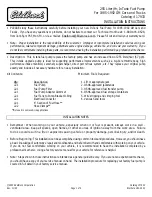
4-23
Driving Downhill
When off
-
roading takes you downhill, you’ll want to
consider a number of things:
D How steep is the downhill? Will I be able to maintain
vehicle control?
D What’s the surface like? Smooth? Rough? Slippery?
Hard
-
packed dirt? Gravel?
D Are there hidden surface obstacles? Ruts?
Logs? Boulders?
D What’s at the bottom of the hill? Is there a hidden
creek bank or even a river bottom with large rocks?
If you decide you can go down a hill safely, then try to
keep your vehicle headed straight down, and use a low
gear. This way, engine drag can help your brakes and
they won’t have to do all the work. Descend slowly,
keeping your vehicle under control at all times.
CAUTION:
Heavy braking when going down a hill can cause
your brakes to overheat and fade. This could
cause loss of control and a serious accident.
Apply the brakes lightly when descending a
hill and use a low gear to keep vehicle speed
under control.
Q:
Are there some things I should not do when
driving down a hill?
A:
Yes! These are important because if you
ignore them you could lose control and have a
serious accident.
D When driving downhill, avoid turns that take you
across the incline of the hill. A hill that’s not too
steep to drive down may be too steep to drive across.
You could roll over if you don’t drive straight down.
D Never go downhill with the transmission in
NEUTRAL (N). This is called “free
-
wheeling.”
Your brakes will have to do all the work and could
overheat and fade.
















































